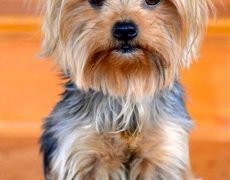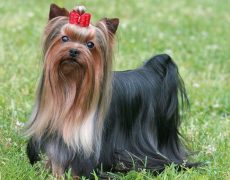Yorkshire Terrier
Yorkshire Terrier or Yorkie, as it is popularly called, is a cute looking companion dog, originating in England’s Yorkshire region, bred to catch rats that thronged the local clothing mills. Brave, feisty, loving, entertaining and affectionate— these traits of the Yorkie make it one of the most sought-after pets.
Yorkshire Terrier Pictures
- Adult Yorkshire Terrier
- Black Yorkshire Terrier
- Mini Yorkshire Terrier
- Pictures of Yorkshire Terriers
- White Yorkshire Terrier
- Yorkshire Terrier Colors Blue & Gold
- Yorkshire Terrier Colors Blue & Tan
- Yorkshire Terrier Dog
- Yorkshire Terrier Images
- Yorkshire Terrier Long Hair
- Yorkshire Terrier Male
- Yorkshire Terrier Photos
- Yorkshire Terrier Pictures
- Yorkshire Terrier Puppies
- Yorkshire Terrier Short Hair
- Yorkshire Terrier Size
- Yorkshire Terrier
- Yorkshire Terriers
- Yorkshire Terrier Colors Black & Tan
- Yorkie
- Teacup Yorkshire Terrier
Quick Information
| Other names | Yorkie |
| Coat | Straight, glossy, fine and silky coat that goes till floor length; woolly or cotton-textured coats (seen in adult Yorkshire Terriers) |
| Color | Blue and tan; black and gold; black and tan; blue and gold |
| Type | Purebred |
| Group | Toy dog; Terrier; Companion dog |
| Size | Small |
| Lifespan/ Life Expectancy | 11to 15 years |
| Height | 7 to 9 inches |
| Weight | 4 to 8 pounds |
| Litter size | 2 to 5 puppies on an average |
| Temperament | Playful; mischievous; high-spirited; outgoing; brave; at times stubborn |
| Good with children | Older ones (above 8 years) |
| Climate Compatibility | Cannot withstand extreme heat and cold temperatures |
| Barking | Excessive |
| Shedding (Do they shed) | Minimal |
| Hypoallergenic | Yes |
| Competitive Registration Qualification/ Information | FCI, ANKC, AKC, CKC, KC (UK), UKC, NZKC |
| Country | England |
Video of Yorkshire Terrier Puppies First Time on Grass
Physical Description
What does a Yorkshire Terrier look like
The Yorkie’s flat head, sets in absolutely well with its well-proportioned body. Its medium-sized, dark eyes bear an intelligent expression, while the V-shaped, erect ears, sitting right on top of its head, adds to its sweet appearance.
How big do Yorkshire Terriers get
The Yorkshire Terriers are small-sized toy breeds that do not grow bigger than 7 pounds.
Teacup Yorkies are a smaller variant of the Yorkshire Terrier, weighing approximately 4 pounds. However, the AKC or other major kennel clubs does not accept it. Moreover, breeding teacup Yorkies are also not a recommendable practice as the litters produced could have a lot of health problems like heart ailment, pelvic pain, seizures and luxating patella.
Are they hypoallergenic
Though according to AKC, a 100% hypoallergenic dog is beyond existence, the Yorkshire Terrier belongs to the list of breeds, perfectly suited for those battling with allergies.
History
Time of origination: They were developed in the Lancashire and Yorkshire counties of England in the mid-19th century.
Purpose: They were created by the Scottish workers who migrated to Lancashire and Yorkshire at the time of the Industrial Revolution, working in woolen and cotton mills. Their pets, mostly comprising various terrier breeds were carried by them everywhere and, used for chasing rats and other rodents present in the mills. The Yorkies were a breed of the working class people developed for the similar reasons. However, with the increase in popularity, they evolved to be a perfect companion for fashionable ladies in the late Victorian era who flaunted their pets by carrying them in their laps.
Breeds responsible for its creation: The Scottish Terriers (here dogs originating in Scotland and not the present day Scottish Terriers) were said to play a pivotal role in creating the breed, alongside other dogs like Paisley Terrier, Skye Terrier, Dandie Dinmont. In fact, a specific source even mentioned the role of Maltese in its creation.
In the previous times, any breed with a blue body, marked with shades of fawn and silver on the legs and head, along with a docked tail and trimmed ears were identified as a Yorkshire Terrier. However, there was a change in this notion and Huddersfield Ben, which had a close resemblance to Paisley-kind Yorkie owned by one Mary Ann Foster of Yorkshire was the forerunner of the present day Yorkshire Terrier breeds.
Breed recognition: The Kennel Club in England was the first to give recognition to this breed in 1886.
The AKC registered the first Yorkie, named Belle, in 1885, post its introduction in the United States in 1872. By the 1940s, there was a reduction in their numbers that was gradually revived, with Smoky, a Yorkie from the Second World War being responsible for the same.
In 2012-2013 AKC ranked it as the 6th purebred on the basis of popularity.
Temperament and Personality
Yorkies have a varying personality, which is mostly shaped by their upbringing, as some of them always seek for royal treatment while a few would display the high-spirited, passionate, brave Terrier-like disposition. Their extremely small-size have earned them the nickname “purse dogs”, tiny enough to be graciously carried in handbags or arms of the proud owners. They are great attention seekers, always craving for companionship, being unhappy when deprived of it. In fact, these cute dogs would follow their masters like shadows from one room to the other.
In spite of their affectionate nature, owing to their Terrier descent, the Yorkies could be wary of strangers, alerting their family by barking excessively the moment they spot any unfamiliar person in their domain.
Though small, it often tries behaving like big dogs, being yappy and boastful, also bringing about chaos and trouble.
They are an excellent choice for older kids and not younger ones who would manhandle them, as these dogs could get yappy if teased or disturbed.
The Yorkies would share a pleasant rapport with other dogs, when brought up with them, though you must be careful before introducing a new pet as they are extremely possessive about their master, not willing to have his love shared, challenging the new intruder and even going to the extent of killing him. They are also unsuited for homes with smaller pets like rabbits or squirrels as they could chase them away.
The appealing traits of the Yorkie may be seen in a whole lot of mixes created by crossing this dog with other purebreds.
Care
Exercise
Though small in size, they require an adequate amount of exercise for their energy to be channelized positively. Daily walks, alongside sufficient playtime, both indoors and outdoors would be sufficient to meet their exercise needs. A problem with the Yorkies is that they can neither withstand heat nor cold, hence keep them inside during this time.
Grooming
The Yorkie’s long, silky, floor-length coat a gentle brushing on a regular basis to prevent any matt or tangle formation. Trim the hair on the top of its head short, or tie it into a knot. Bathing it once a week with a vet-approved shampoo is needed to maintain the shine on its coat. Avoid brushing the coat when it is dirty or even dry as this could lead to hair breakage. Trimming its nails, brushing its teeth to prevent tartar buildup as well as cleaning its eyes and ears are the other necessary grooming measures.
Health Problems
The Yorkie is generally a healthy breed but may suffer from certain health conditions like bronchitis, luxating patella, lymphangiectasia (dilation of the lymph vessels), progressive retinal atrophy, hypoglycemia, collapsed trachea, reversed sneezing alongside eye infections as well as dental problems.
Training
Being given the 34th position in Coren’s “The Intelligence of Dogs”, these dogs would be able to grasp training well because of the sharp brains. However, an experienced taskmaster is needed who would be able to control their stubborn nature firmly.
Socialization
It is of utmost importance to acquaint the Yorkshire Terrier to different kinds of experiences as well as people so that it would be able to differentiate a friend from a foe and not attack every unfamiliar face that it comes across.
Obedience
They need to be obedience-trained since they can get extremely yappy and stubborn at times. Acquainting them with commands like “stop” and “quiet” would help in keeping their barking in check.
Housetraining
Housetraining these dogs is often said to be a challenge and must be done since the time it is a puppy. Maintain a proper feeding schedule and make sure that he does not munch onto any tidbit before his mealtime. You should take it out for eliminating once it wakes up in the morning and then keep doing that in every hour or two-hour span. You should take your Yorkie to the same place each time for excretion so that it could relate the two actions well.
Crate training
Keeping its separation anxiety problem in mind, you should train it how to stay in a crate at a young age. Get it used to a crate first and gradually increase the timespan.
Feeding
Half to three-fourths cups dry dog food would be good for your Yorkie. Before giving it homemade treats, you would need to remember that their digestive system is extremely delicate and consumption of food beyond their regular diet could trigger diarrhea or vomiting.
Interesting Facts
- Smokey, the hero of the 2nd World War, because of its remarkable and fearless feats like pulling wire through a tunnel of 70 feet width.
- Pasha, the pet of U.S. president Richard Nixon, was a Yorkie and lived in the White House during his tenure.
- A matchbox-sized Yorkie named Sylvia was known to be the dog of the smallest size as historical records stated.


























